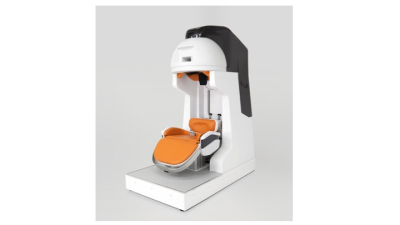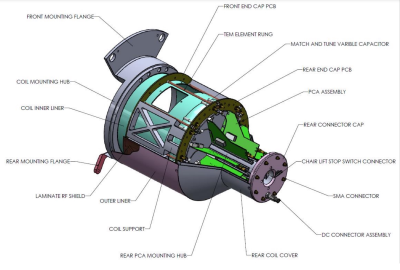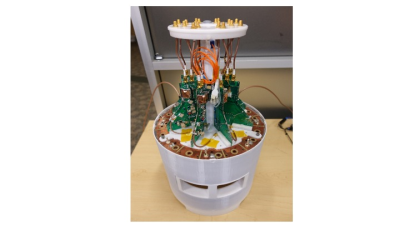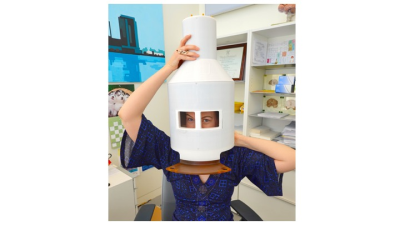0137
An RF Coil for a Head-Only MR System1Biomedical Engineering, Radiology, Columbia University, New York, NY, United States, 2Virtumed, LLC, Minneapolis, MN, United States, 3University of Minnesota, Minneaoplis, MN, United States, 4University of Minnesota, Minneapolis, MN, United States
Synopsis
A new RF coil and frontend for a head-only, 1.5T fMRI system was designed, built and demonstrated. This coil features the ability for single and multichannel transceiver operation for transmit-receive switched and simultaneous transmit and receive (STAR) operation. It includes a window and an integrated shield. First applications will be for voluntary motor control studies in humans.
Objective
Our objective was to design, build and demonstrate a compact, versatile, RF coil for use with an experimental, head-only, 1.5T MRI system.Introduction
Current MRI systems of 1.5T and higher with sufficient SNR for human fMRI studies rely on superconducting solenoidal magnets that limit the range of motion for voluntary motor control experiments that require extension of the limbs. We have designed a new type of MR system to make "Imaging Human Brain Function with Minimal Restrictions"possible for planned motor control studies.1,2 See Figure 1. For this system we needed an RF head coil with new capabilities. The coil tuned to 64 MHz required whole-head coverage while stopping well above the shoulders. It needed to be very compact while transmitting and receiving and being shielded without eddy current generation from the multi-coil spatial encoding elements.3 It required an ample sized window for a relatively uninterrupted visual field to allow eye-hand coordinated movements. This coil also was to serve as an engineering platform to facilitate a number of different experimental configurations including linear drive, circularly polarized drive, multi-channel transmit and receive, transmit-receive (TR) switched operation and simultaneous transmit and receive (STAR).4Methods
The coil design chosen to meet these many and various requirements was an eight-channel transceiver TEM coil.5 This design without parasitic end rings projects an axial FOV longer than an equal length birdcage to allow for whole head coverage with a necessarily short structure, but still retains the homogenous close, peripheral field coverage of a cage design unlike transmit loop array elements. Eight elements not connected by end rings are easy to drive independently as needed and to RF shim to compensate for the large window. The shielded coil design also makes for a compact and close-fitting coil inside the multi-coil array. The head coil as drawn in Figure 2, measured 245mm i.d. x 298mm o.d. x 515 mm overall length. The coil's eight coaxial elements were 5mm o.d. x 220mm long with a 274mm deep head space. They were individually fine-tuned with Voltronics NMNT23-6 trimmer caps. The window measured 67mm x 173mm. The coil had a back plane dividing the head space from the RF front end electronics consisting of eight G-10 boards (green), each containing a PIN switch with Macom MA4PK3000 diodes, and a WanTcom GaAsFET preamp. These connectorized boards were interchangeable with CMOS non-magnetic circulators for simultaneous transmit and receive (STAR) operation.6 The entire coil was packaged in a printed polycarbonate body. Figure 4 shows the built coil with the RF electronics chamber opened to reveal the circuit boards in this case comprising eight TR switched, preamplified channels. Circulator boards with preamps would replace these TR boards with the same board form and connectors.Results
The coil was successfully tuned to 64 MHz and impedance matched on an human head load. With our head-only MRI system being not yet complete, we tested the RF coil on a 1.5T whole-body system. Driving two channels in quadrature, with the protocol sequence parameters listed in Figure 5, we achieved the figure's results in our scout images to verify basic coil operation and coverage. In these initial raw images without any signal leveling, we see that we've achieved good whole-head coverage with this compact 1.5T coil. Two additional copies of this coil have been built to give multi-channel transmit and STAR options without having to change boards and connections. We hope to present results from these variations in the coming year.Conclusion
Heretofore the TEM coil which was developed and primarily used for high-field applications has proven to be a useful 1.5T coil as well, showing homogeneous, whole-head coverage in a compact, close-fitting design. This coil demonstrates many options for single and multi-channel application for conventional TR switched and STAR operation.Acknowledgements
U01 PI Michael Garwood, U. Minnesota and subcontract co-PIs, Gilberto Gonzales, MGH/Harvard; Robin de Graaf, Yale, Christoph Juchem, Columbia; Ben Parkinson, Victoria, NZ; Brasil; Sung Min Sohn, Arizona State U.; Alberto Tannús, USP São Carlos.
This work was supported and was also performed at the Zuckerman Mind Brain Behavior Institute MRI Platform, a shared resource, and Columbia MR Research Center site.
References
1.) NIH NIBIB U01- EB025153, M. Garwood, PI. "Imaging Human Brain Function with Minimal Restrictions"
2.) Vaughan, J. T. et al. Progress toward a portable MRI system for human brainimaging. Proc. Intl Soc. Mag. Reson. Med. 24, 0498 (2016).
3.) Juchem, C., S. Theilenberg, C. Kumaragamage, M. Mullen, L. DelaBarre, G. Adriany, P.B. Brown, S. McIntyre, T.W. Nixon, M. Garwood, and R.A. de Graaf, Dynamic multi-coil technique (DYNAMITE) MRI on human brain. Magn Reson Med, 2020.
4.) Sohn S-M, Vaughan JT, Lagore RL, Garwood M, Idiyatullin D. In vivo MR imaging with simultaneous RF transmission and reception. Magnetic Resonance in Medicine. 201676(6):1932-1938.
5.) Vaughan, J.T.: “RF Coil for Imaging System” US Patent Serial 6,633,161 (2003)
6.) Nagulu, Kord, Tong, Garwood, Vaughan, Krishnaswamy. "STAR MRI with Non-magnetic, Integrated Circulator based on Switched Transmission Lines. ISMRM Proceedings, 2021.
Figures




